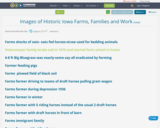
Historical images of Iowa farmers, farms, families and their work on the farm
- Subject:
- History
- Material Type:
- Diagram/Illustration
- Date Added:
- 05/02/2017

Historical images of Iowa farmers, farms, families and their work on the farm
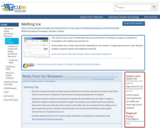
This activity uses a mix of multimedia resources and hands-on activities to support a storyline of investigation into melting sea and land ice.

Supervised Agricultural Experiences (SAE) and Record Keeping have long been a crucial and significant component of the three-circle model of a complete agricultural education program. SAE’s and the affiliated records open opportunities for students to experience success in the FFA degree and proficiency award applications. The Agricultural Experience Tracker (AET) serves as a conduit linking student record keeping, activity documentation, SAE visits, SAE photos, and even career exploration into a digital platform which is classroom ready and meets the needs of ALL students in the classroom.
A series of videos will address a broad overview of SAE’s and their associated documents. From these videos, hopefully you will be able to glean some best practices to create a user-designed tool to manage SAE’s, student involvement, and your time investment with your students and programs.
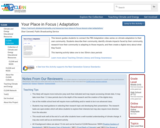
This lesson guides students to connect the PBS Adaptation video series on climate adaptation to their own community. Students describe their community, identify climate impacts faced by their community, research how their community is adapting to those impacts, and then create a digital story about what they found.
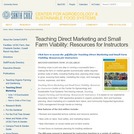
For farmers, growing crops is just one step in running a successful farm—making the farm or market garden economically viable requires another suite of skills, including finding land, planning what crops to grow, marketing the crops, and managing income and expenses. This resource builds on our experience educating hundreds of apprentice growers in organic production, farm and business planning, direct marketing at a roadside farm stand, and Community Supported Agriculture (CSA) management through hands-on training in the running of our 100-member CSA program. Teaching Direct Marketing and Small Farm Viability: Resources for Instructors is organized into six units, three focusing on marketing and three covering other topics related to making a small farm economically viable. Included are lessons and resources for running a CSA project, selling at farmers' markets, forming collaborative marketing groups and grower cooperatives, and selling to restaurants. Also covered are strategies to improve small farm planning, including enterprise visioning and market assessment; creating a business plan, including marketing and crop plans; and managing cash flow. Land tenure options such as cash-rent leases from non-profits, shared ownership models, conservation easements, and community land trusts are reviewed as additional mechanisms for addressing the complex issue of the economic viability of small-scale agriculture. This resource also reviews the trends and factors that influence small-scale agriculture's economics, and provides an overview of produce marketing in the U.S. The training manual is designed for – •Instructors at college and universities, agriculture organizations, farm-training programs, apprenticeship programs •Agricultural extension personnel •Farmers with interns •Growers, teachers, and organizers at urban farms, community gardens, and food projects with direct-marketing outlets This instructor's resource features class and field demonstration outlines, trainee exercises, and resource materials, with a focus on CSA. The manual can be used in a classroom setting or adapted for other training formats, such as short courses, conferences, and field days.
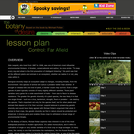
In The Botany of Desire, Michael Pollan explores risks inherent in one of the most widespread practices in modern agriculture. It's called monoculture, and it refers to cultivation of single or very similar varieties of a food crop on large acreages. In many cases, the variety is one that dominates the marketplace, like the Russet Burbank potato, whose shape makes it a favorite for cutting French fries, or one of the few apple varieties commonly seen in supermarkets. Monoculture may offer economic advantages, but Pollan argues that it brings serious environmental risks.

Market to Market is a part of the Iowa Public Television. The website includes videos of feature stories and market analysis by analyst Ted Seifried. In addition, there is Market to Market in the classroom where there are videos on business, technology and science of agriculture.
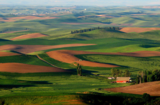
The unit from Central Valley School District in Washington, is focused on the examination of geography in terms of “place.” Students dive into inquiry to answer the compelling question, What is unique about living in Washington? Through this question students will understand where and why people live in Washington State. Students will dive into the regions of Washington State and define it through many characteristics. Students will ultimately choose a region to become an expert on and communicate what makes that region unique. Each student’s performance task product will reflect choice and build upon student strengths according to their skill set.
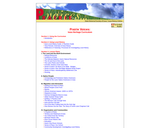
This website provides local Iowa history, lesson plans, fun facts, resources and a timeline of Iowa history. The lesson plan’s collection includes land and built environment, native people, migration and interaction, organization and communities, work and folk life.
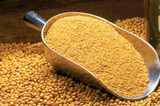
How does the nutrient content of cereal grains and their by-products change as they are processed? In this lesson, students will determine the presence of starch and protein in common feedstuffs used in the livestock agriculture industry.
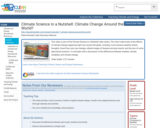
This video is part of the Climate Science in a Nutshell video series. This short video looks at the effects of climate change happening right now around the globe, including: more extreme weather events, droughts, forest fires, land use changes, altered ranges of disease-carrying insects, and the loss of some agricultural products. It concludes with a discussion of the differences between weather, climate variability, and climate change.
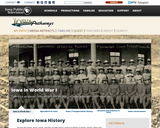
Discover the people, places, events, and ideas of Iowa history. Explore hundreds of articles, images, videos and websites. Create your own story of Iowa as you go to unexpected places and search the past and present. Travel down side trails and uncover artifacts as you explore your Iowa pathway.
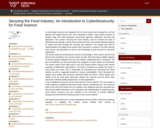
As technology becomes ever integrated into our food system and everyday life, our food industry and supply become ever more vulnerable to attack. Cyber attacks continue to threaten large and small companies, government agencies, individuals, and food and agriculture. This module, ‘Securing the Food Industry,’ aims to introduce the idea of cyberbiosecurity through a lecture format along with three case studies allowing students to interact and think through the concepts and materials. This module was built for implementation into college level courses with connection or interest in the food industry, food science, and agriculture as well as and technology courses focused on real world applications.
The lecture starts by introducing the amount of technology in food science and the food industry then transitions into concerns about security. After discussing multiple subtypes of security already integrated into the food industry, cyberbiosecurity is introduced. The term and definition are discussed before the categories of cyber attacks are introduced. The lecture relates these ideas back to the food industry before sharing a few real-life examples of detrimental cyber-attacks. The lecture concludes are explain the impact a cyber attack can cause, who is responsible for preventing and recovering from these attacks, as well as suggested practices to reduce vulnerabilities. Three theoretical but realistic case studies with discussion questions follow the lecture. These studies were written to act as small group discussion starters but could be used for whole class discussion, individual writing assignments, or other applications.
A list of additional resources can be found with the course material. This list provides a small sampling of additional documents which discuss cyberbiosecurity. The resources listed at the end of the lecture are not included in the additional resources document but also provide helpful information in the exploration and understanding of cyberbiosecurity. Food science resources are also included in this document to provide additional background around the food industry portion of this course material.
Securing the Food Industry is an open educational resource (OER). Instructors reviewing, adopting, or adapting the module should indicate their interest at https://forms.gle/orFRGhYs8owBP7gD6.
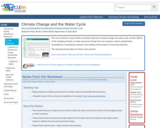
This unit consists of seven distinct activities that teach climate change, the water cycle, and the effects of the changing climate on water resources through the use of games, science experiments, investigations, role-playing, research, and creating a final project to showcase learning.
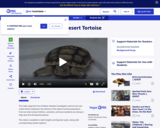
This video segment from Outdoor Nevada examines threats to the desert tortoise population.
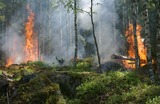
The students will be introduced to a historical account of global climate change and the human events that may have impacted those changes. Fire has been used by humans throughout history to modify their environment, particularly forests, for human benefit. Over time, the management of forests has changed and the result is an increase in catastrophic wildfires. This storyline explores the use of fire as a forest management tool to improve the health of forests thereby decreasing the incidence of catastrophic fires and the role fire plays in climate change.
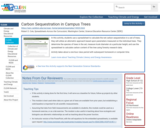
In this activity, students use a spreadsheet to calculate the net carbon sequestration in a set of trees; they will utilize an allometric approach based upon parameters measured on the individual trees. They determine the species of trees in the set, measure trunk diameter at a particular height, and use the spreadsheet to calculate carbon content of the tree using forestry research data.
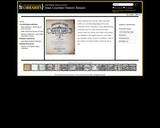
Here you can find nearly all of Iowa’s 99 counties atlases in digital collection. In addition, county atlases from the late 1800s and the early 1900s are being digitized.

This task was developed by high school and postsecondary mathematics and agriculture sciences educators, and validated by content experts in the Common Core State Standards in mathematics and the National Career Clusters Knowledge & Skills Statements. It was developed with the purpose of demonstrating how the Common Core and CTE Knowledge & Skills Statements can be integrated into classroom learning - and to provide classroom teachers with a truly authentic task for either mathematics or CTE courses.
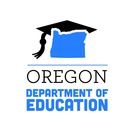
This lesson explores the preservation and revitalization of Indigenous languages—why it’s important and what tribes in Oregon are doing to keep their ancestral languages alive. This is important for many Native American tribes, who are attempting to save their languages from “linguicide” caused by decades of colonialism and forced assimilation. Language revitalization can help restore and strengthen cultural connections and pride, which in turn can promote well-being for both tribes and their members.